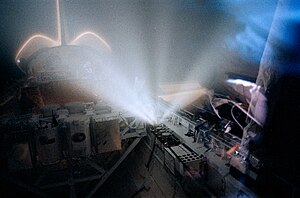Critical ionization velocity
The phenomenon was predicted by Swedish engineer and plasma scientist, Hannes Alfvén, in connection with his model on the origin of the Solar System (1942).
[4] In 1973, Lars Danielsson published a review of critical ionization velocity, and concluded that the existence of the phenomenon "is proved by sufficient experimental evidence".
When an abandoned lunar [391] excursion module was made to impact on the dark side of the Moon not very far from the terminator, a gas cloud was produced which when it had expanded so that it was hit by the solar wind gave rise to superthermal electrons.
[11] In 1992, E. Golbraikh and M. Filippov argued that critical ionization velocity could play a role in coronal mass ejections and solar flares,[12] and in 1992, Anthony Peratt and Gerrit Verschuur suggested that interstellar neutral hydrogen emissions bore the signature of critical velocity ionization,.
In other words, a neutral gas falling from infinity toward the Sun is stopped at a distance ri where it will accumulate, and perhaps condense into planets.
[16] After criticising the "Inadequacy of the Homogeneous Disc Theory", he writes: ".. it is more attractive to turn to the alternative that the secondary bodies derive from matter falling in from "infinity" (a distance large compared to.
